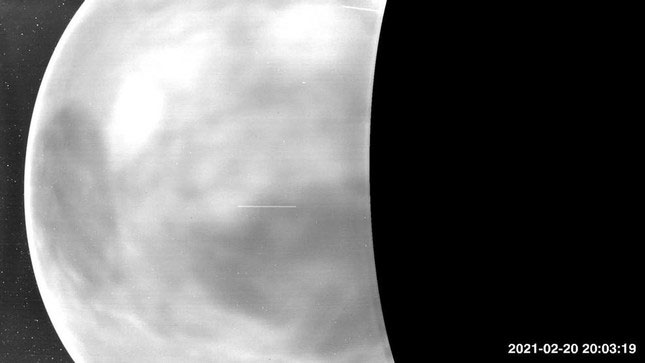NASA captures the first beautiful images of the surface of Venus
Stunning images captured by NASA's Parker Solar Probe offer the first glimpse of Venus's red-hot surface, revealing the continents, plains and plateaus of the volcanically etched world. harsh. The images may hold clues to Venus's mysterious past.
Observing beneath the dense and toxic clouds of Venus with the Parker Solar Probe (WISPR) wide-field imager, NASA scientists have discovered a series of geological formations that glow in the faint light. of Venus' nighttime surface, along with a luminescent halo of oxygen in the planet's atmosphere.
The groundbreaking images, taken during the fourth flight of the Parker Solar Probe to Venus en route to the Sun, will provide scientists with valuable insights into the geology and minerals of the planet. this scorching hot planet, they may also reveal more about why Venus has become so inhospitable while life on Earth flourished.
NASA scientists published this new analysis February 9 in the journal Geophysical Research Letters.

The surfaces of Venus were imaged by NASA's Parker probe.
"Venus is the third brightest object in the sky, but until recently we didn't know much about its surface because our view of it was blocked by a thick atmosphere. Now, we're finally here. finally seen the surface with visible wavelengths for the first time from space," said study lead author Brian Wood, a physicist at the Navy's Research Laboratory in Washington.
The surface of Venus has been photographed before, but this is the first time it has been photographed in light visible to the human eye. Because the planet is inherently covered with a toxic crust densely packed with sulfuric acid and carbon dioxide, which blocks most of the light from escaping.
Parker Probe's WISPR instrument was originally built to study the Sun's atmosphere and solar wind, but its sensitivity allows it to capture the planet's faint light.
During the day, the red light of Venus is drowned out by sunlight. However, flying at night has allowed the probe to recognize the planet's soft light and beautiful geographical features on its surface.
As WISPR detects wavelengths between the visible and infrared spectrums, it also allows scientists to estimate the surface temperature of Venus. It is about 462 degrees Celsius and is the hottest planet in our Solar System, even at night.
"The surface of Venus, even at night, is about 860 degrees Celsius," Wood said. "So hot that the rocky surface of Venus glows, like an iron being pulled from a forge."
Scientists don't know if Venus has always been as barren as it is today, and previous studies suggested the planet could have harbored water and even life before it was enveloped by a greenhouse gas haze. .
NASA's Parker probe will continue to probe Venus in November 2024. NASA's Veritas and Da Vinci missions will expand the US space agency's knowledge of the planet's surface by sending an orbiter and an atmospheric probe to the planet.
These missions are expected to launch sometime between 2028 and 2030. The European Space Agency will also send its own orbiter, EnVision, to scan the planet's surface.
These projects will likely unlock the secrets of Venus' past, and possibly even serve as a chilling warning to one of the possible futures on Earth.
- NASA concussion statement about Venus
- NASA wants to bring people to Venus
- NASA simulates Venus's hellish environment
- Uncover the mysterious surface of the planet
- NASA simulates spacecraft falling into 'hell' of Venus
- NASA captures evidence of Earth-like planet 2 billion years ago
- NASA announces picturesque satellite imagery
- Venus is about to be a
- Interesting things about the planet
- This planet may once have brought life
- NASA announces stunning images of Saturn
- Venus suddenly turned slower
 Van Allen's belt and evidence that the Apollo 11 mission to the Moon was myth
Van Allen's belt and evidence that the Apollo 11 mission to the Moon was myth The levels of civilization in the universe (Kardashev scale)
The levels of civilization in the universe (Kardashev scale) Today Mars, the sun and the Earth are aligned
Today Mars, the sun and the Earth are aligned The Amazon owner announced a secret plan to build a space base for thousands of people
The Amazon owner announced a secret plan to build a space base for thousands of people